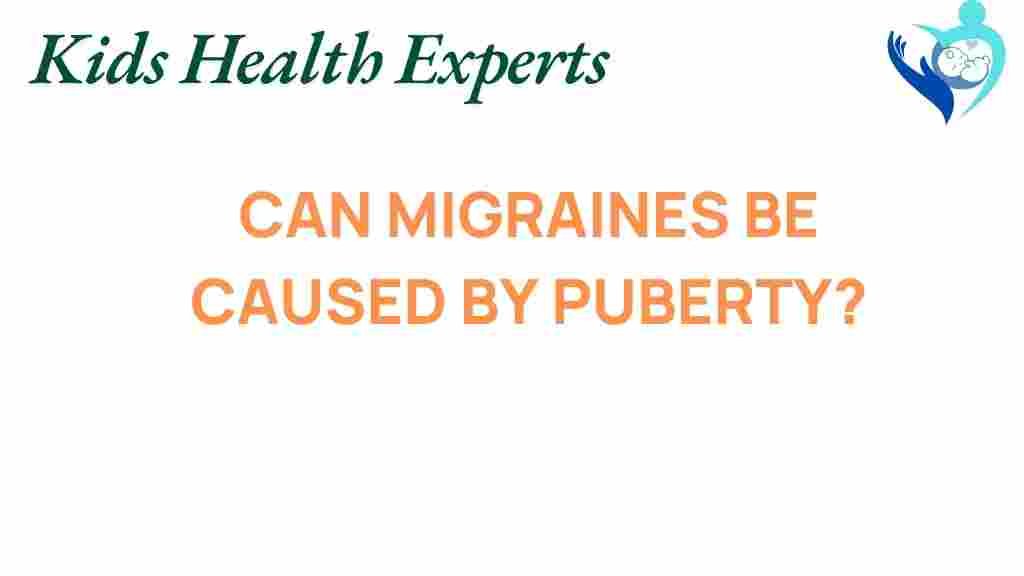Unraveling the Mystery: Can Puberty Trigger Migraines?
As teenagers transition through puberty, their bodies undergo significant changes, both physically and emotionally. One of the less discussed aspects of this developmental phase is the potential for migraines to emerge or intensify during this time. In this article, we will explore the relationship between puberty and migraines, focusing on headache triggers, hormonal changes, and adolescent health.
Understanding Migraines
Migraines are more than just severe headaches; they are a neurological condition characterized by intense, debilitating pain often accompanied by additional symptoms such as nausea, vomiting, and sensitivity to light and sound. Understanding the nature of migraines is crucial, especially for adolescents who may be experiencing them for the first time.
- Symptoms: Migraines typically present with throbbing pain, often on one side of the head.
- Duration: They can last from a few hours to several days.
- Triggers: Common headache triggers include stress, certain foods, hormonal changes, and lack of sleep.
Puberty and Hormonal Changes
Puberty marks a significant period of hormonal changes in both boys and girls. These changes can influence various aspects of health, including the onset of migraines. During puberty, the body produces higher levels of hormones, such as estrogen and testosterone, which can contribute to the frequency and severity of migraines.
- Estrogen: In females, fluctuations in estrogen levels can be a major headache trigger, with many girls experiencing migraines related to their menstrual cycle.
- Testosterone: In males, changes in testosterone levels can also affect headache patterns, though research is less extensive in this area.
Medical Research on Puberty and Migraines
Recent medical research has begun to unravel the intricate relationship between puberty and migraines. Studies have shown that:
- Adolescent girls are more likely to experience migraines after they begin menstruating, indicating a strong link between hormonal changes and headache triggers.
- Research suggests that boys are more likely to experience migraines before puberty, while girls see an increase post-puberty.
- There is a genetic component to migraines, meaning that adolescents with a family history of migraines are at an increased risk.
For more comprehensive insights, you can refer to this medical research article that discusses the impact of hormonal changes on adolescent migraine patterns.
Recognizing Headache Triggers in Adolescents
Identifying headache triggers is essential for effective pain management in adolescents. Here are some common headache triggers that may affect teenagers:
- Stress: Academic pressures and social dynamics can lead to increased stress levels, potentially triggering migraines.
- Diet: Certain foods, such as aged cheeses, chocolate, and caffeine, can provoke migraines.
- Sleep Patterns: Irregular sleep schedules or lack of sleep can exacerbate migraine occurrences.
- Environmental Factors: Bright lights, loud noises, and strong smells are common environmental triggers.
Step-by-Step Process to Manage Migraines During Puberty
Managing migraines effectively requires a multi-faceted approach. Here’s a step-by-step guide tailored for adolescents:
Step 1: Maintain a Migraine Diary
Encouraging teens to keep a migraine diary can help identify specific triggers. This diary should include:
- Date and time of the migraine
- Duration and intensity of pain
- Activities before the migraine onset
- Dietary intake, including meals and snacks
- Sleep patterns and stress levels
Step 2: Consult a Healthcare Provider
It’s crucial to involve a healthcare professional who specializes in adolescent health. They can help in:
- Diagnosing the type of headaches
- Recommending appropriate treatments
- Discussing preventive measures and medication options
Step 3: Explore Pain Management Techniques
Various pain management techniques can be employed, including:
- Medication: Over-the-counter pain relievers, such as ibuprofen or acetaminophen, may be effective for mild migraines.
- Prescription Medications: For more severe cases, doctors may prescribe triptans or other migraine-specific medications.
- Alternative Therapies: Techniques such as acupuncture, biofeedback, and cognitive behavioral therapy may help reduce migraine frequency.
Step 4: Lifestyle Modifications
Encouraging healthy lifestyle choices can significantly impact adolescent wellness. Consider:
- Regular Exercise: Physical activity can help reduce stress and improve overall health.
- Healthy Eating Habits: Focus on a balanced diet rich in fruits, vegetables, whole grains, and hydration.
- Sleep Hygiene: Establishing a consistent sleep schedule can help mitigate sleep-related triggers.
Troubleshooting Tips for Parents and Teens
For parents and teens dealing with migraines, here are some troubleshooting tips to consider:
- Stay Calm: Remind teens that migraines are common and manageable. Stress can exacerbate their headaches.
- Support System: Encourage open communication about symptoms and experiences. Support from family and friends is crucial.
- Learn Together: Educate yourselves about migraines and effective coping strategies.
- Be Patient: Finding the right treatment may take time, so be patient with the process.
Conclusion
Understanding the connection between puberty and migraines is essential for effective adolescent health management. Hormonal changes during puberty can indeed trigger migraines, making it vital for parents, teens, and healthcare providers to work together in recognizing headache triggers and implementing effective pain management strategies.
By maintaining a migraine diary, consulting healthcare professionals, and making necessary lifestyle changes, adolescents can navigate this challenging phase with greater ease. Remember, you are not alone in this journey; support is available, and effective management is possible.
For further reading on teenage wellness and health strategies, visit this resource page that offers valuable insights.
This article is in the category Conditions and created by KidsHealthExperts Team
